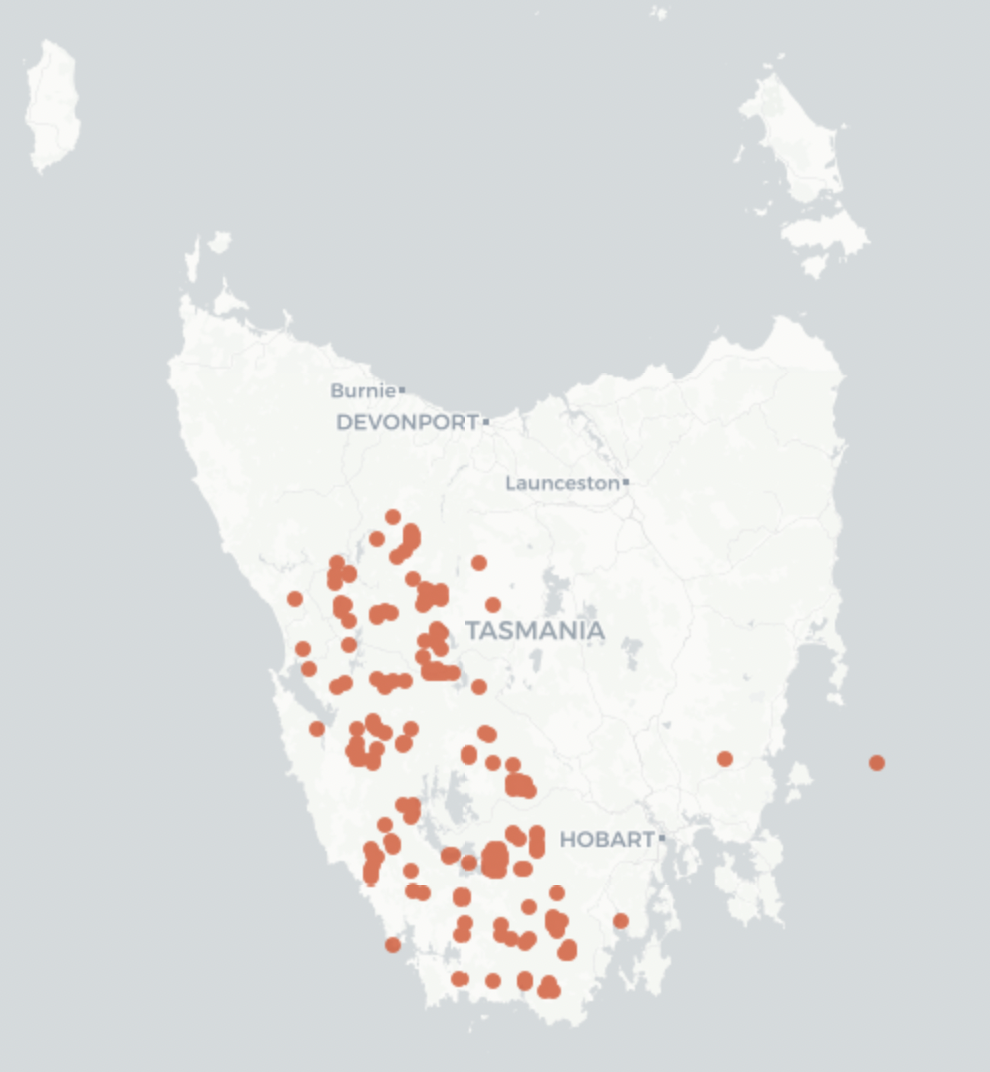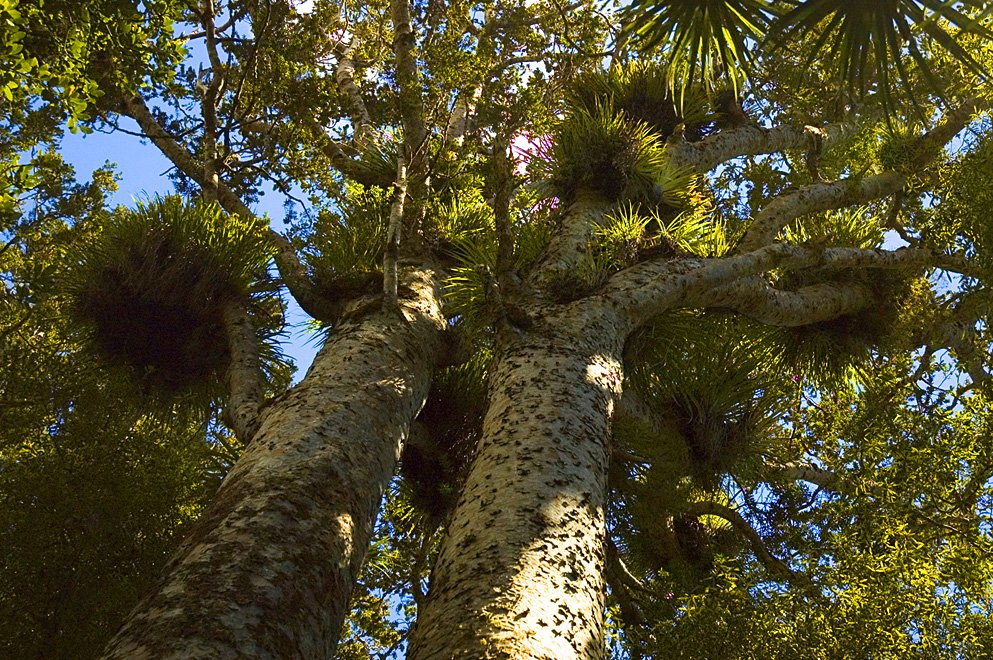|
Asteliaceae
Asteliaceae is a family of flowering plants, placed in the order Asparagales of the monocots. The family has only recently been recognized by taxonomists. The APG III system of 2009 (unchanged from the 1998 and 2003 versions) does recognize this family. The family includes three genera with about 38 species, occurring in the Southern Hemisphere. It is bird/insect pollinated and its conservation status as of 2017 is not threatened. Description A large variation in morphology is seen within this family. Roots The main cell type of the vascular tissue system present in roots are tracheids. Roots are the only plant organs to have vessel elements and this is seen commonly in Monocots. The habitat of a monocot will determine different xylem characteristics. The habitat of Asteliaceae gives rise to the variation seen in the xylem. These tracheary elements have pores in their walls from fragments of the pit membrane. The vessels that are present within Asteliaceae have very primitive ... [...More Info...] [...Related Items...] OR: [Wikipedia] [Google] [Baidu] |
Milligania
''Milligania'' is a genus of native perennial plants containing five species which are all found in Tasmania: *''Milligania densiflora'' Hook.f. *''Milligania johnstonii'' F.Muell. ex Benth. *''Milligania lindoniana'' Rodway ex W.M.Curtis *''Milligania longifolia'' Hook.f. *''Milligania stylosa'' (F.Muell. ex Hook.f.) F.Muell. ex Benth. Formerly belonging to the Liliaceae family, ''Milligania'' is now a part of the Asteliaceae family. Three of these species are alpine and subalpine, with the remaining two rare species growing along rivers in the south-west of the state. All five species are restricted to very wet habitats and are typically found growing on waterlogged peat. They are known to form extensive rough mats. Description Plants within this genus are perennial, Rhizome, rhizomatous, tufted herbs with short stems, often forming small clumps. Leaves The broad, leathery leaves exhibit a triangular shape with pleats resembling those found in the ''Astelia'' genus''.'' L ... [...More Info...] [...Related Items...] OR: [Wikipedia] [Google] [Baidu] |
Asparagales
Asparagales (asparagoid lilies) are a diverse order of flowering plants in the monocots. Under the APG IV system of flowering plant classification, Asparagales are the largest order of monocots with 14 families, 1,122 genera, and about 36,000 species, with members as varied as asparagus, orchids, yuccas, irises, onions, garlic, leeks, and other Alliums, daffodils, snowdrops, amaryllis, agaves, butcher's broom, Agapanthus, Solomon's seal, hyacinths, bluebells, spider plants, grasstrees, aloe, freesias, gladioli, crocuses, and saffron. Most species of Asparagales are herbaceous perennials, although some are climbers and some are trees or shrubs. The order also contains many geophytes (bulbs, corms, and various kinds of tuber). The leaves of almost all species form a tight rosette, either at the base of the plant or at the end of the stem, but occasionally along the stem. The flowers are not particularly distinctive, being 'lily type', with six tepals and ... [...More Info...] [...Related Items...] OR: [Wikipedia] [Google] [Baidu] |
Astelia
''Astelia'' is a genus of flowering plants in the recently named family Asteliaceae. They are rhizomatous tufted perennial plant, perennials native to various islands in the Pacific, Indian, and South Atlantic Oceans, as well as to Australia and to the southernmost tip of South America. A significant number of the known species are endemic to New Zealand., search for "Astelia" The species generally grow in forests, swamps and amongst low alpine vegetation; occasionally they are epiphytic. Species The genus is divided into a number of subgenera and these are further divided into sections. These contain the following species: * subgenus ''Astelia'' ** section ''Astelia'' *** ''Astelia alpina'' R.Br. - Pineapple Grass, Silver Astelia, native to eastern Australia **** ''Astelia alpina'' var. ''alpina'' **** ''Astelia alpina'' var. ''novae-hollandiae'' Skottsb. *** ''Astelia papuana'' Skottsb.- native to New Guinea *** ''Astelia linearis'' Hook.f.- native to North and South Isl ... [...More Info...] [...Related Items...] OR: [Wikipedia] [Google] [Baidu] |
Astelia Hemichrysa
''Astelia'' is a genus of flowering plants in the recently named family Asteliaceae. They are rhizomatous tufted perennials native to various islands in the Pacific, Indian, and South Atlantic Oceans, as well as to Australia and to the southernmost tip of South America. A significant number of the known species are endemic to New Zealand., search for "Astelia" The species generally grow in forests, swamps and amongst low alpine vegetation; occasionally they are epiphytic. Species The genus is divided into a number of subgenera and these are further divided into sections. These contain the following species: * subgenus ''Astelia'' ** section ''Astelia'' *** ''Astelia alpina'' R.Br. - Pineapple Grass, Silver Astelia, native to eastern Australia **** ''Astelia alpina'' var. ''alpina'' **** ''Astelia alpina'' var. ''novae-hollandiae'' Skottsb. *** '' Astelia papuana'' Skottsb.- native to New Guinea *** '' Astelia linearis'' Hook.f.- native to North and South Islands of New Zea ... [...More Info...] [...Related Items...] OR: [Wikipedia] [Google] [Baidu] |
Neoastelia
''Neoastelia '' is a genus of plants in the family Asteliaceae containing the single species ''Neoastelia spectabilis'', commonly known as the silver sword lily, that is endemic to a small area on the Northern Tablelands of New South Wales, Australia. It is a species of herb with long, linear leaves and large groups of whitish flowers, followed by spherical, pale green berries. Description ''Neoastelia spectabilis'' is a tufted herb with more or less linear leaves long and wide with drooping ends, and silvery white on the lower surface. The flowers are arranged in panicles long on a thick peduncle long. Each panicle consists of smaller, many-flowered racemes with a spathe at the base, the individual flowers whitish and wide on a pedicel long. Flowering occurs from November to December and the fruit is an oval to spherical, pale green berry long containing between 70 and 150 small black seeds. Taxonomy ''Neoastelia spectabilis'' was first formally described in 1987 by J.B ... [...More Info...] [...Related Items...] OR: [Wikipedia] [Google] [Baidu] |
APG III System
The APG III system of flowering plant classification is the third version of a modern, mostly molecular-based, system of plant taxonomy being developed by the Angiosperm Phylogeny Group (APG). Published in 2009, it was superseded in 2016 by a further revision, the APG IV system. Along with the publication outlining the new system, there were two accompanying publications in the same issue of the Botanical Journal of the Linnean Society: * The first, by Chase & Reveal, was a formal phylogenetic classification of all land plants (embryophytes), compatible with the APG III classification. As the APG have chosen to eschew ranks above order, this paper was meant to fit the system into the existing Linnaean hierarchy for those that prefer such a classification. The result was that all land plants were placed in the class Equisetopsida, which was then divided into 16 subclasses and a multitude of superorders. * The second, by Haston ''et al.'', was a linear sequence of families fol ... [...More Info...] [...Related Items...] OR: [Wikipedia] [Google] [Baidu] |
APG System
The APG system (Angiosperm Phylogeny Group system) of plant classification is the first version of a modern, mostly molecular-based, system of plant taxonomy. Published in 1998 by the Angiosperm Phylogeny Group, it was replaced by the improved APG II in 2003, APG III system in 2009 and APG IV system in 2016. History The original APG system is unusual in being based, not on total evidence, but on the cladistic analysis of the DNA sequences of three genes, two chloroplast genes and one gene coding for ribosomes. Although based on molecular evidence only, its constituent groups prove to be supported by other evidence as well, for example pollen morphology supports the split between the eudicots and the rest of the former dicotyledons. The system is rather controversial in its decisions at the family level, splitting a number of long-established families and submerging some other families. It also is unusual in not using botanical names above the level of order, that is, an ... [...More Info...] [...Related Items...] OR: [Wikipedia] [Google] [Baidu] |
APG IV System
The APG IV system of flowering plant classification is the fourth version of a modern, mostly molecular-based, system of plant taxonomy for flowering plants (angiosperms) being developed by the Angiosperm Phylogeny Group (APG). It was published in 2016, seven years after its predecessor the APG III system was published in 2009, and 18 years after the first APG system was published in 1998. In 2009, a linear arrangement of the system was published separately; the APG IV paper includes such an arrangement, cross-referenced to the 2009 one. Compared to the APG III system, the APG IV system recognizes five new orders ( Boraginales, Dilleniales, Icacinales, Metteniusales and Vahliales), along with some new families, making a total of 64 angiosperm orders and 416 families. In general, the authors describe their philosophy as "conservative", based on making changes from APG III only where "a well-supported need" has been demonstrated. This has sometimes resulted in placements th ... [...More Info...] [...Related Items...] OR: [Wikipedia] [Google] [Baidu] |
Order (biology)
Order () is one of the eight major hierarchical taxonomic ranks in Linnaean taxonomy. It is classified between family and class. In biological classification, the order is a taxonomic rank used in the classification of organisms and recognized by the nomenclature codes. An immediately higher rank, superorder, is sometimes added directly above order, with suborder directly beneath order. An order can also be defined as a group of related families. What does and does not belong to each order is determined by a taxonomist, as is whether a particular order should be recognized at all. Often there is no exact agreement, with different taxonomists each taking a different position. There are no hard rules that a taxonomist needs to follow in describing or recognizing an order. Some taxa are accepted almost universally, while others are recognized only rarely. The name of an order is usually written with a capital letter. For some groups of organisms, their orders may follow consist ... [...More Info...] [...Related Items...] OR: [Wikipedia] [Google] [Baidu] |
Boryaceae
Boryaceae is a family of highly drought-tolerant flowering plants native to Australia, placed in the order Asparagales of the monocots. The family includes two genera, with twelve species in total in Australia. Until recently, this family was not recognized by many taxonomists, with most systems putting the two genera, '' Borya'' and '' Alania'', in the Anthericaceae or the Liliaceae. The 2016 APG IV system (unchanged from the 1998, 2003 and 2009 versions) does recognize this family and places it in the order Asparagales, in the clade monocots, based on molecular phylogenetic evidence that shows the two genera form a clade In biology, a clade (), also known as a Monophyly, monophyletic group or natural group, is a group of organisms that is composed of a common ancestor and all of its descendants. Clades are the fundamental unit of cladistics, a modern approach t .... References External links''Borya'' in western Australialinks at CSDL, Texas * {{Taxonbar, from=Q89430 ... [...More Info...] [...Related Items...] OR: [Wikipedia] [Google] [Baidu] |
Gondwana
Gondwana ( ; ) was a large landmass, sometimes referred to as a supercontinent. The remnants of Gondwana make up around two-thirds of today's continental area, including South America, Africa, Antarctica, Australia (continent), Australia, Zealandia, Arabian Peninsula, Arabia, and the Indian subcontinent. Gondwana was formed by the Accretion (geology), accretion of several cratons (large stable blocks of the Earth's crust), beginning with the East African Orogeny, the collision of India and Geography of Madagascar, Madagascar with East Africa, and culminating in with the overlapping Brasiliano orogeny, Brasiliano and Kuunga orogeny, Kuunga orogenies, the collision of South America with Africa, and the addition of Australia and Antarctica, respectively. Eventually, Gondwana became the largest piece of continental crust of the Paleozoic Era, covering an area of some , about one-fifth of the Earth's surface. It fused with Laurasia during the Carboniferous to form Pan ... [...More Info...] [...Related Items...] OR: [Wikipedia] [Google] [Baidu] |







